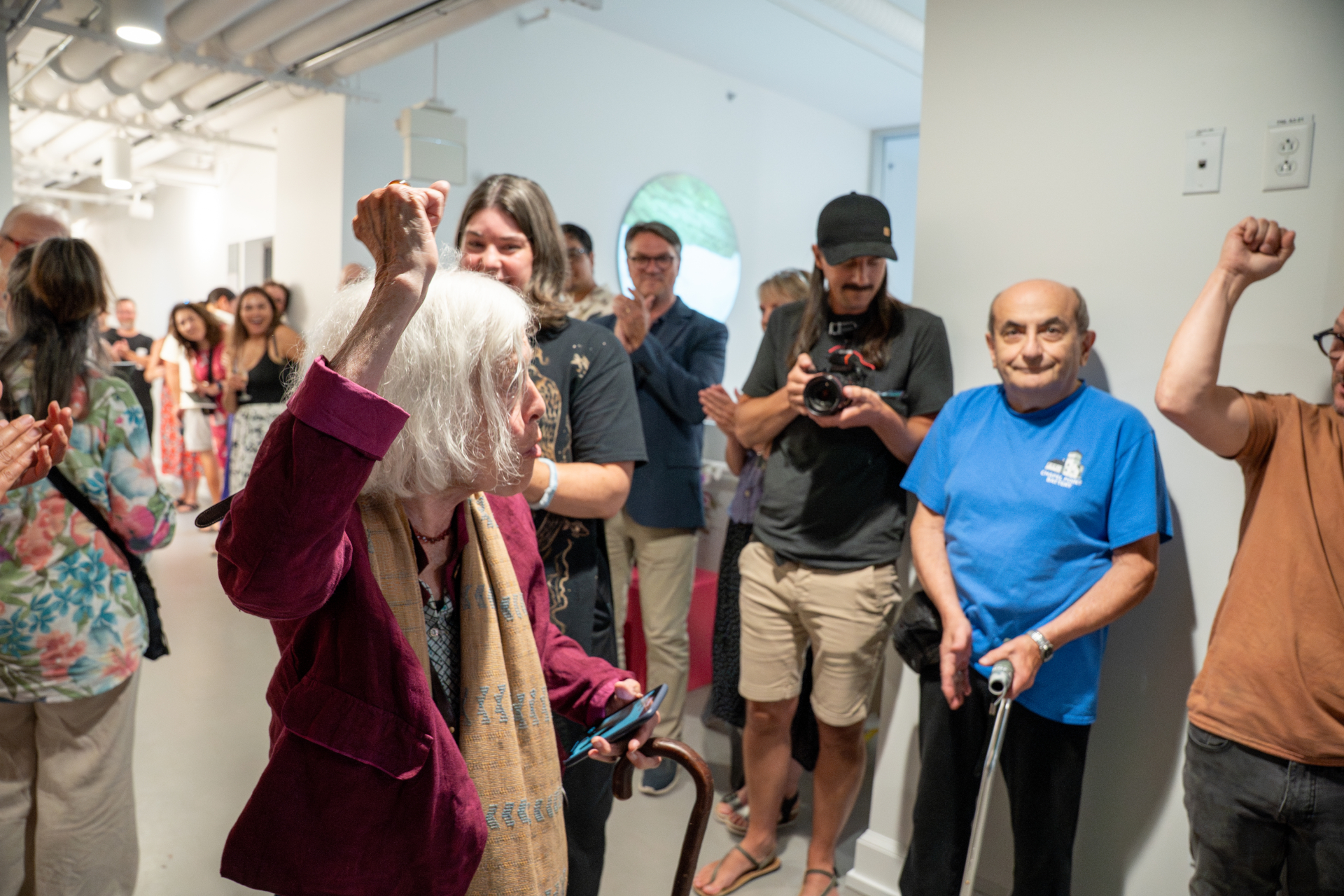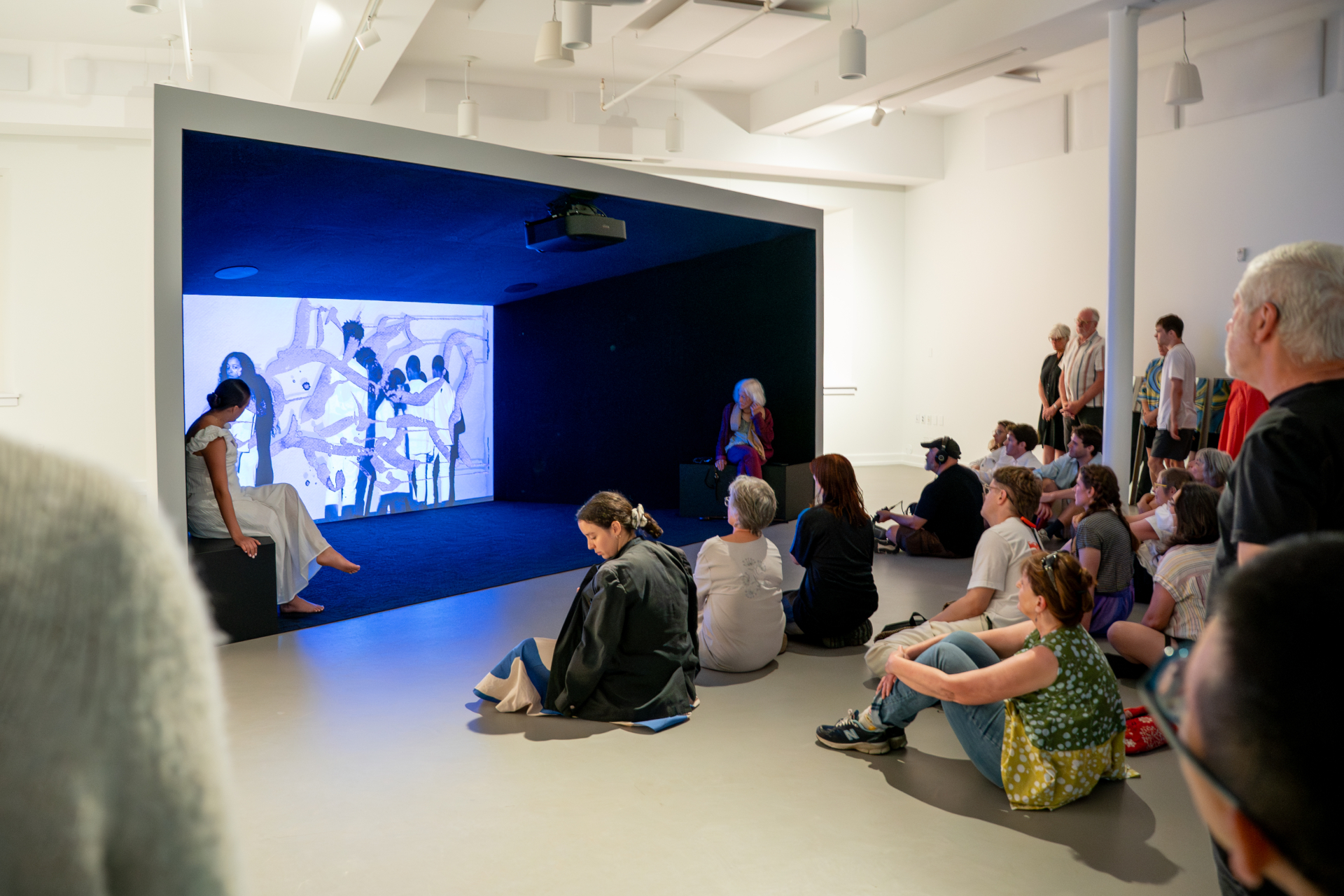August 9, 2025 · Posted by Ardelle Reynolds
CHRISTIE MACNEIL & MELISSA KEARNEY: We Come from the Edge of the Sea
Cape Breton Post, August 9, 2025
Cape Breton Post, August 9, 2025

This late summer, the ocean takes a different form — not as tide, but as art: shadow and shimmer, colour on mirrors, movement, texture, and sound.
In Sydney, at the eastern edge of Unama’ki, Cape Breton Island, at Eltuek Arts Centre, Joan Jonas’s exhibition We come from the sea opens in all three galleries and runs through to October 12. It is the Canadian debut of a major work, the first time Jonas has shown in this country.
The marine biologist Rachel Carson once wrote: The edge of the sea is a strange and beautiful place. All through the long history of Earth it has been an area of unrest where waves have broken heavily against the land, where the tides have pressed forward over the continent, receded, and then returned. For no two successive days is the shoreline precisely the same. Today a little more land may belong to the sea, tomorrow a little less. Always the edge of the sea remains an elusive and indefinable boundary.
Carson, a brilliant writer and conservationist, gave us both poetry and warning. Her work has inspired generations — including Jonas and this exhibition, and many of us within the Eltuek ecosystem — her prose alive with beauty but sharpened by the foresight of nature unraveling under the weight of human hubris and the economic forces that propel it.
In Cape Breton, there is an dà shealladh — second sight, or the two sights — the psychic gift of seeing what is here, what has been, and what is coming. Carson held it in her science, Jonas carries it in her art. Both are Seers in their own ways, seeing the world as it is, and as it will be, if we are willing to look.
Joan Jonas is a visionary of video and performance whose experiments have shaped the language of contemporary art for more than fifty years.
In person, she is both unassuming and luminous, a phosphorescence about her — very Cape Breton. In art, she is epic — a feminist tour de force whose influence extends across generations and disciplines: performance, video, installation, film, painting, and drawing.
Her work has been celebrated on some of the world’s most significant stages, with major retrospectives and career honours marking her as one of the defining artists of the past half-century.
We come from the sea follows its North American debut at the Museum of Modern Art in New York and now opens first in Unama’ki — before Toronto, Montreal, Vancouver, or even Halifax. This is rare, and extraordinary. The exhibition’s centrepiece, Moving Off the Land II, is a layered installation: ocean life as art form, evolution, grief, climate change.
Jonas has lived in Inverness County for over fifty summers, in a small wooden house, along eroding and shifting cliffs, overlooking west coast sunsets. The light over the water is never the same twice. She looks out to the horizon the way Cape Bretoners do, the way Cape Bretoners have done for centuries — reading its changes, looking to it for clues, searching for questions and answers, letting it guide and ground us in our day-to-day lives.

Carson understood the long rhythms of earth and sea, the beauty and quiet mystery of the low-tide world, where life gleams and clings at the edge. Jonas’s work moves within that same rhythm, between art and nature, memory and present, wonder and warning. Cape Breton lives there too, carrying its own magic and complicated history, a strange and beautiful place with a strange and beautiful people.
An dà shealladh. Some of us have carried this second sight all our lives — seeing in dreams, in visits in the morning light, a knowing of things to come. It is the same sight that shaped Eltuek’s own beginning, a story of magic and sheer will against the tide.
In 2010, a group of artists saw what wasn’t there yet. In 2020, after years of work, vision, and spirit in the face of disbelief, Eltuek opened its doors. The name Eltuek, which means (we) are making (it) together, was given by Mi’kmaw Elders to honour the First Language of this Island. It says exactly what it means. This place can hold the work of the world and still be of this place.
Having Joan Jonas’s work here somehow feels both inevitable and impossible. It’s a gift.
And it matters, too, that the work is also being shown at the Inverness County Centre for the Arts (ICCA). Eltuek and ICCA, east and west, are like two harbours on the same coast, holding this moment together.
Moments like this don’t happen by accident. They happen because places like Eltuek are nurtured and sustained, by care, persistence, and vision. A community that can hold this work and conversation can be anything, after decades of being told it couldn’t.
The artist’s sight — of what is here, what has been, and what is coming — has always been with us. It lives in an dà shealladh, in Carson’s writings and warnings, in Jonas’s art, and in L’nu knowledge which has seen and known the past, present, and future of these lands and waters of Unama’ki since time immemorial. The exhibition opens here not by coincidence, but as part of that long continuum of seeing.
This is for all of us who feel the pull of this place — the sea, the light, the history, and its future. Who notice the slow shifts of the shoreline, the way the beaches change with each passing season, year over year. We know something is happening, and we carry it. We come from the sea gathers that knowing — holding it and stewarding a conversation with those whose legacy is rooted in these waters, and those still learning how to listen.
As the sea around us is deep and wide, so too is our gratitude — to Joan, her collaborators, and the many artists, makers, and thinkers whose work and care brought this exhibition into being, and to Eltuek Arts Centre.
We hope you will join us in this moment.
Christie MacNeil is Director of Arts and Community, and Melissa Kearney is Artistic Director, at New Dawn.
